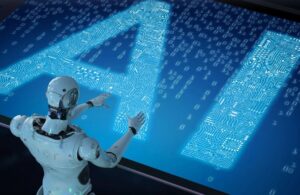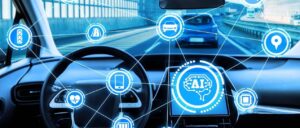Exploring the World of AI-Enabled Technologies
As we continue to develop intelligent machines that can solve complex problems and even perform tasks that were once solely the domain of humans, it is crucial to understand the fundamental concepts, applications, and ethical considerations of AI-enabled technologies.
In doing so, we can effectively harness their potential to not only improve various industries and sectors but also ensure that these advancements are built upon a foundation of ethical principles and responsible development.
Understanding Artificial Intelligence
Artificial Intelligence (AI)
AI is a broad term that refers to the development of computer systems capable of performing tasks that typically require human intelligence.
These tasks may include speech recognition, visual perception, decision-making, language translation, and even creative problem-solving.
The field of AI is incredibly diverse, with multiple branches and approaches dedicated to achieving the goal of creating intelligent machines.
To have a better understanding of AI and its implications, it is crucial to explore its history, relationship with machine learning and deep learning, and the main types of AI, such as narrow AI and general AI.
History of Artificial Intelligence
The concept of artificial intelligence can be traced back to ancient myths and stories, where intelligent machines were portrayed as powerful and often mysterious entities.
However, the formal birth of AI as a scientific field can be attributed to a conference held at Dartmouth College in the United States in 1956, where a group of computer scientists and researchers gathered to discuss the possibility of creating machines capable of human-level intelligence.
This sparked a surge of interest and research in AI, which has continued to the present day.
For several decades, AI development focused mainly on rule-based systems or symbolic AI, wherein machines were programmed to perform specific tasks following a set structure using symbols and rules.
However, limitations in this approach became apparent as the complexity of tasks increased.
Machine Learning and Deep Learning
In recent years, a significant shift has occurred in AI research, moving away from rule-based systems towards a more data-driven approach known as machine learning.
Machine learning allows computers to learn and improve their performance on a task without being explicitly programmed. This is achieved by feeding data to algorithms, which then find patterns and correlations within the data, enabling machines to make predictions and decisions.
Deep learning is a subset of machine learning, which uses neural networks to recognise more complex patterns within data.
Neural networks are mathematical models inspired by the human brain, consisting of layers of interconnected nodes or “neurons”. Deep learning has been pivotal in the development of powerful AI applications, specifically in fields such as computer vision, natural language processing, and speech recognition.
Narrow AI and General AI
There are two main categories of AI: narrow AI and general AI. Narrow AI, also known as weak AI, refers to systems that are designed and trained for specific tasks without possessing human-like intelligence.
Examples of narrow AI include speech recognition systems, recommendation algorithms, and image recognition software. Although these systems can be incredibly sophisticated and perform their designated tasks with high accuracy, they are limited in their scope and general applicability.
On the other hand, general AI, sometimes called strong AI, refers to systems that possess human-like intelligence and can understand, learn, and apply their knowledge across a wide range of tasks. Currently, no such AI system exists, and achieving this level of artificial intelligence remains a long-standing goal of AI research.
General AI would be able to perform any intellectual task that a human can do, and would involve a deep understanding of emotions, social interaction, and human behaviour.
Applications of AI
AI-enabled applications are becoming ever more present in our everyday lives – from virtual assistants such as Siri and Alexa, to self-driving cars and recommendation systems on streaming platforms.
In the business realm, AI is employed to enhance efficiency, make more accurate predictions, and customise products and services to cater to individual consumer preferences.
Another notable sector where AI is being embraced is healthcare, with algorithms being developed to assist in diagnosing illnesses, personalising treatment plans, and predicting patient outcomes.
While the benefits of AI-driven technologies are vast, concerns have been raised regarding potential risks and ethical implications. Issues such as job displacement, data privacy, and algorithmic bias must be addressed as we continue to develop and integrate AI into our society.
Striking a balance between reaping the rewards of AI and tackling its challenges is crucial for harnessing the full potential of these incredible technologies and shaping a better future for all.
Applications of AI-Enabled Technologies
Artificial Intelligence Applications in Various Industries
Continuing from the previous paragraph’s overview of AI-enabled technologies, we will delve deeper into how these applications are permeating various industries, causing far-reaching transformations and offering innovative solutions to problems that have long plagued different sectors.
In this section, we will explore the applications of AI-enabled technologies in various fields, including healthcare, finance, transportation, and manufacturing.
By examining the profound impact of AI in these sectors, we will gain a deeper understanding of both the potential benefits and the challenges that must be addressed as we continue on this technological journey.
Healthcare
In the healthcare sector, AI-enabled applications significantly improve the accuracy and efficiency of diagnostics, as well as the development of personalized treatment plans.
Machine learning algorithms can analyze vast amounts of medical data, assisting doctors in the early detection of diseases such as cancer, heart disorders, and neurological conditions.
Medical imaging technologies, powered by AI, can provide more precise scan interpretations and reduce the rate of false positives. AI applications are also accelerating drug discovery processes by predicting drug interactions, reducing the time and cost required for pharmaceutical development.
Moreover, AI-powered telemedicine tools enable remote diagnosis and remote monitoring, making healthcare more accessible to patients in rural and under-served areas.
Another potential advantage of AI in healthcare is its application in robotic surgery, which allows surgeons to carry out complex procedures with precision, reducing the risk of complications and promoting faster recovery.
Finance
The financial sector greatly benefits from the incorporation of AI-enabled technologies in activities such as risk management, fraud detection, and investment decision-making.
Machine learning algorithms can accurately assess a client’s creditworthiness, improving loan approval processes and reducing default rates. In fraud detection, AI systems can quickly identify patterns and anomalies, which significantly reduces losses due to cybercrime.
Additionally, AI has made a remarkable impact on investment through robo-advisory platforms, which help users manage their finances and investments optimally according to their risk appetite.
Algorithmic trading powered by AI can analyze real-time market data, enabling traders and investors to capitalize on fast-changing conditions and improve their decision-making processes.
Transportation
One of the most critical applications of AI in the transportation sector is the development of autonomous vehicles. Self-driving cars have the potential to revolutionize transportation by making it safer, more efficient, and environmentally friendly.
AI-enabled sensors and systems enable vehicles to navigate complex environments and respond to traffic conditions in real time.
Apart from autonomous vehicles, AI is also employed in advanced traffic management systems to optimize traffic flow, predict and manage congestion, and improve road safety.
Public transportation systems can utilize AI applications to provide accurate real-time information and optimize schedules and routing, thus enhancing the passengers’ experience.
Manufacturing
AI-enabled technologies have a significant impact on the manufacturing industry, where they are used to optimize processes, increase efficiency and reduce costs.
One such application is predictive maintenance, where AI can analyze data from sensors and machinery to predict when equipment may fail, preventing unexpected downtime and costly repairs.
Another aspect where AI plays a crucial role is quality control.
AI-powered inspection systems can identify defects and errors in produced goods, ensuring that only items meeting the required standards are shipped to customers.
AI also supports the development of smart manufacturing processes, where data from various sources is used to inform production decisions, enhancing flexibility and adaptability.
Ethical Considerations in AI-Enabled Technologies
Ethical Considerations
With the rapid advancement of artificial intelligence (AI) technologies and their widespread applications, ethical considerations have come to the forefront of discussion.
The potential risks and implications of AI-enabled technologies pose a range of ethical concerns relating to privacy, security, job displacement, and algorithmic biases.
To safeguard society and ensure that AI is used responsibly, it is essential to address these issues with a balanced approach that includes the perspectives of governments, businesses, and individuals.
Privacy
One of the most significant ethical concerns surrounding AI is the potential violation of privacy. AI-enabled technologies, such as facial recognition systems, machine learning algorithms, and data mining tools, rely on massive amounts of personal data in order to function.
The collection, storage, and analysis of such data can pose significant privacy risks if not handled properly. Anonymisation techniques, data encryption, and rigorous data protection regulations are essential means to protect individuals’ privacy when using AI systems.
Security
AI systems are vulnerable to various security threats, which raises concerns about the potential misuse, hacking, or abuse of these technologies.
For instance, AI-generated deepfake videos can be used for misinformation, while automated cyberattacks powered by AI can pose significant threats to a nation’s cyberinfrastructure.
To mitigate these risks, it is vital to invest in robust security measures and protocols that keep AI technologies secure, while also promoting collaboration between organisations to develop comprehensive frameworks for detecting and mitigating threats.
Job Displacement
The automation and efficiency brought about by AI advancements have led to concerns about job displacement and the potential for an increase in unemployment.
Many low-skilled, manual labour, and repetitive job roles are at risk of being replaced by AI-enabled machines and systems.
In order to minimise the impact of AI on job displacement, it is vital to promote lifelong learning, upskilling, and reskilling programmes for workers in affected industries, and to explore new job opportunities arising from the AI sector.
Algorithmic Biases
AI systems learn from the data they are fed, which can potentially lead to biases in their output if the input data contains cultural, gender, or other biases.
This has led to concerns about discrimination and bias in AI-enabled technologies, such as predictive policing tools, automated hiring systems, and facial recognition software.
Addressing these biases requires a diligent and insightful approach to AI development, which includes working to identify and correct these biases in data sets, continuously monitoring AI-enabled technologies for signs of bias, and striving for transparency in algorithms.
Responsible AI Development
AI developers and organisations have a responsibility to ensure that their technologies are ethically created and used.
This includes developing and implementing ethical guidelines, embedding ethical considerations into the research and development process, and maintaining transparency in the development and deployment of AI systems.
Encouraging open dialogue and collaboration among the tech community can help in fostering responsible innovation in this field.
Government and Regulatory Agencies
Governments and regulatory agencies have a crucial role in ensuring the ethical use of AI-enabled technologies by enacting appropriate legislation and regulations to protect individuals and businesses.
These agencies should consider proactive approaches to monitoring AI developments, creating regulatory frameworks that promote trust in and accountability for AI systems, and facilitating international cooperation to harmonise regulatory efforts across borders.
Challenges and Future Directions of AI-Enabled Technologies
Artificial Intelligence (AI): Challenges and Opportunities
AI has revolutionised various industries by automating processes, enhancing accuracy, and opening up new growth opportunities. Nevertheless, AI-enabled technologies face numerous limitations and challenges, some of which are explored in this article:
Data Quality
A crucial challenge faced by AI-enabled technologies is ensuring data quality. AI algorithms require vast amounts of accurate and relevant data to function effectively.
However, guaranteeing data accuracy can be time-consuming and costly, posing a significant obstacle for organisations wishing to implement AI solutions.
Furthermore, as more AI technologies are developed, the issue of data privacy comes into sharp focus. There is a pressing need to balance the benefits of AI with the protection of individuals’ privacy rights.
Lack of Standardization
Another challenge faced by AI-enabled technologies is the lack of standardization in AI development.
This lack of standardization can make it difficult for organisations to assess the suitability and effectiveness of various AI solutions, leading to slower technology adoption and increased costs.
Efforts are being made to address this limitation by establishing common standards and protocols for AI development.
These efforts, when successful, will lead to increased interoperability and ease of use across various AI platforms, enabling more seamless integration of AI technologies into daily workflows and processes.
Computational Power
AI technologies require significant computational power to process and analyze vast amounts of data.
This need for computational resources can be a limiting factor for organizations looking to adopt AI-enabled technologies as the costs can be prohibitive.
The energy consumption required for these powerful systems is becoming a growing concern, necessitating research into ways to make AI computing more sustainable without sacrificing performance.
Future Directions and Trends of AI enabled Technology
Despite the challenges faced by AI-enabled technologies, advancements in AI research continue to unlock exciting opportunities for the future.
Developments in areas such as transfer learning and federated learning hold the potential to overcome limitations associated with data quality and privacy.
AI is also being applied in new fields, such as healthcare, agriculture, climate change mitigation, and more, showcasing the broad range of potential applications for this transformative technology.
Additionally, the development of Explainable AI (XAI) aims to address the issue of AI’s “black box” problem, where the internal workings of the algorithms are difficult to decipher.
In conclusion, while AI-enabled technologies face several challenges, they are essential drivers of innovation and progress across multiple industries.
Through further research, development, and standardization, the future of AI holds the promise of improving productivity, solving complex problems, and enhancing the quality of life for people worldwide.
Ultimately, the realm of AI-enabled technologies is vast and its potential impact on our society immense.
By delving into the fundamental concepts and exploring real-world applications, we can better appreciate the transformative nature of these innovations.
Yet, it is equally important to address the ethical concerns and challenges that emerge with such rapid progress.
It is only through a comprehensive understanding of these aspects that we can navigate a path to a future where AI-enabled technologies are responsibly developed and deployed, benefitting both individuals and society as a whole.



















